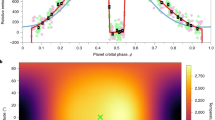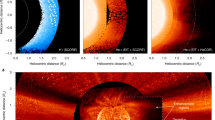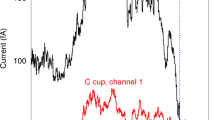Abstract
The Ly α measurements of the hydrogen corona of Venus by Mariners 5 (ref. 1) and 10 (ref. 2) have been shown to be consistent with a two temperature component model. Bertaux et al.3 have successfully fitted the Venera 9 exospheric Ly α data with an elevated (500 K) single temperature; however, they also indicated that their data are not inconsistent with a two component model. Various source mechanisms have been proposed to explain the ‘hot’ (∼1,000 K), energetic component of the hydrogen corona. Here we use recent results from the Pioneer Venus Orbiter (PVO)4 to establish the major sources of this hot hydrogen population.
This is a preview of subscription content, access via your institution
Access options
Subscribe to this journal
Receive 51 print issues and online access
$199.00 per year
only $3.90 per issue
Buy this article
- Purchase on Springer Link
- Instant access to full article PDF
Prices may be subject to local taxes which are calculated during checkout
Similar content being viewed by others
References
Anderson, D. E., Jr J. geophys. Res. 81, 1213 (1976).
Kumar, S. & Broadfoot, A. L. Paper presented at IAGA/IAMAP Meet. Seattle (1977).
Bertaux, J. L. et al. Planet. Space Sci. 26, 817 (1978).
See Science 203, 743–808 (1979); 205, 41–121 (1979).
Kumar, S., Hunten, D. M. & Broadfoot, A. L. Planet. Space Sci. 26, 1063 (1978).
Sze, N. D. & McElroy, M. B. Planet. Space Sci. 23, 763 (1975).
Chamberlain, J. W. J. geophys. Res. 82, 1 (1977).
Stewart, A. I. Paper presented at Conf. on Planetary Atmospheres, Tucson (1968).
Ferrin, I. R. thesis, Univ. Colorado (1976).
Taylor, Jr et al. Science 205, 99 (1979).
Knudsen, W. C. et al. Science 205, 107 (1979).
Chandrasekhar, S. Radiative Transfer (Dover, New York, 1960).
Nagy, A. F. & Banks, P. M. J. geophys. Res. 75, 6260 (1970).
McDaniel, E. W. Collision Phenomena in Ionized Gases (Wiley, New York, 1964).
Niemann, H. B. et al. Science 205, 54 (1979).
Kumar, S. & Hunten, D. M. J. geophys. Res. 79, 2529 (1974).
cf. Chamberlain, J. W. Theory of Planetary Atmospheres (Academic, New York, 1978).
Author information
Authors and Affiliations
Rights and permissions
About this article
Cite this article
Cravens, T., Gombosi, T. & Nagy, A. Hot hydrogen in the exosphere of Venus. Nature 283, 178–180 (1980). https://doi.org/10.1038/283178a0
Received:
Accepted:
Issue Date:
DOI: https://doi.org/10.1038/283178a0
This article is cited by
-
The Long-Term Evolution of the Atmosphere of Venus: Processes and Feedback Mechanisms
Space Science Reviews (2022)
-
Neutral Upper Atmosphere and Ionosphere Modeling
Space Science Reviews (2008)
Comments
By submitting a comment you agree to abide by our Terms and Community Guidelines. If you find something abusive or that does not comply with our terms or guidelines please flag it as inappropriate.



